Are you curious about the value of your 1929 wheat penny or considering adding one to your Lincoln coin collection?
You’ve come to the right place! In this guide, we’ll explore everything you need to know about the value of a 1929 wheat penny.
We will take a look at the coin’s history, its distinctive features, and how much it’s worth in different conditions—whether circulated or uncirculated.
As an older coin, the 1929 wheat penny is seldom found in mint condition. If you happen to own one that’s uncirculated, it could be worth a considerable amount, potentially reaching into the hundreds of dollars!
Let’s dive in and find out what your 1929 Lincoln cent might be worth.
1929 Wheat Penny Value Chart
| Mint Mark | Good | Fine | Extremely Fine | Uncirculated |
|---|---|---|---|---|
| 1929 No Mint Mark Penny | $0.30 | $0.42 | $3.54 | $9.80 |
| 1929-S Wheat Penny | $0.60 | $2.08 | $8.45 | $30 |
| 1929-D Wheat Penny | $0.60 | $1.53 | $8.45 | $59 |
The History of the 1929 Wheat Penny
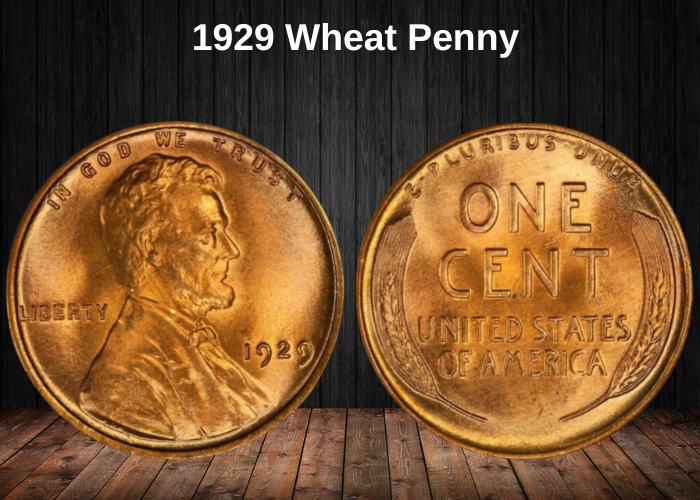
The Lincoln cent, which began being struck in 1909, was created to commemorate the bicentennial anniversary of Abraham Lincoln’s birth. The coin’s redesign came as part of President Theodore Roosevelt’s efforts to refresh the designs of several U.S. coins, including the four gold coins and the cent.
In 1905, Roosevelt appointed sculptor Augustus Saint-Gaudens to design new versions of these coins. Saint-Gaudens completed his designs for the gold coins but passed away before he could submit designs for the cent.
As a result, Victor David Brenner, another sculptor, was chosen to complete the redesign. Brenner’s proposed design featured a portrait of President Abraham Lincoln on the obverse, while the reverse displayed two wheat ears, earning the coin its nickname, the wheat penny.
Interestingly, Brenner had previously worked with Roosevelt, creating a portrait of Lincoln for the Panama Canal Commission. It is believed that Roosevelt, impressed with this portrait, recommended Brenner to the Mint, which eventually led to the selection of his design for the cent.
In the early production of these coins, Brenner included his initials (DVB) on the reverse of the coin, but this caused public controversy. The initials were quickly removed from future designs. However, a small number of DVB-initialed coins were minted before the change, leading collectors to name these early coins “DVB” pennies.
Initially, the wheat pennies were made of 95% copper, but in 1943, the Mint switched to a zinc-coated steel due to copper shortages during World War II. This change was only temporary, and in 1944, the original copper composition resumed. However, in 1982, the rising cost of copper led to the introduction of a zinc core with a copper coating for Lincoln cents, a composition that remains in use today.
The Lincoln penny is still minted by the U.S. Mint today, although its design has evolved over the years.
Features of the 1929 Wheat Penny
The Obverse of the 1929 Wheat Penny
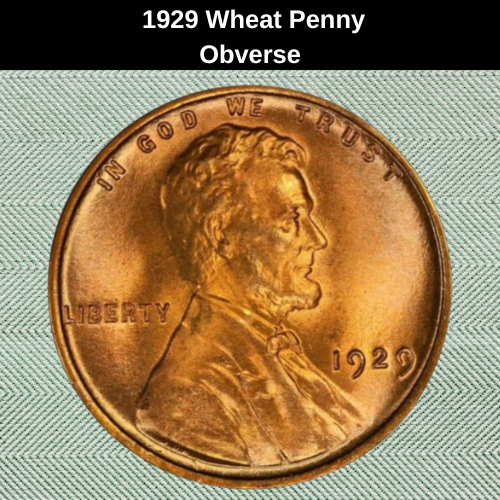
The obverse (or head side) of the 1929 wheat penny features a right-facing portrait of President Abraham Lincoln, which occupies the majority of the coin’s surface. The design is simple yet powerful, capturing Lincoln’s likeness with great detail.
At the top of the coin, above Lincoln’s head, the words “IN GOD WE TRUST” are inscribed along the inner rim. To the left of the portrait, behind Lincoln’s back, the word “LIBERTY” is prominently displayed. Finally, the date of minting, 1929, is positioned to the right of Lincoln’s portrait.
This design, with its elegant simplicity, reflects both the solemnity and reverence with which the nation holds its 16th president, Abraham Lincoln.
The Reverse of the 1929 Wheat Penny
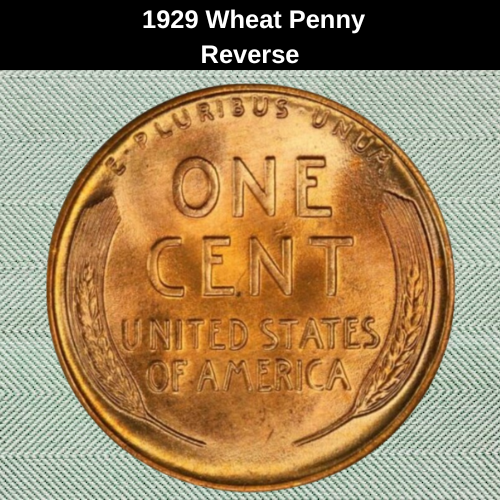
The reverse of the 1929 wheat penny features a simple yet symbolic design. Two wheat stalks frame the coin, one on the left and the other on the right, symbolizing the nation’s agricultural heritage.
In the center of the coin, the denomination “ONE CENT” is prominently displayed. Below it, the inscription “UNITED STATES OF AMERICA” is featured, marking the origin of the coin.
At the top, along the inner rim of the coin, the motto “E PLURIBUS UNUM” is inscribed, meaning “Out of many, one.” This phrase represents the union of the states and is a key part of the country’s national identity.
The reverse design, though simple, reflects both the agricultural roots of the United States and the ideals of unity and nationhood.
Other Features of the 1929 Wheat Penny
The 1929 wheat penny has the following features:
- Diameter: 19.00 millimeters
- Weight: 3.11 grams
- Composition: 95% copper, 5% tin and zinc
- Edge: Plain
You can find a mint mark on the obverse, right beneath the date:
- “S” for coins struck at the San Francisco Mint.
- “D” for coins struck at the Denver Mint.
Pennies minted in Philadelphia do not have a mint mark.
These details help to identify the origin of the coin, and the mint mark often affects the value of the coin, with certain mint marks being rarer or more sought after by collectors.
1929 Wheat Penny Grading
The 1929 wheat penny, like many early wheat pennies, was struck with varying quality. From 1915 to the mid-1930s, weak dies often resulted in coins with poor strikes, and this can be seen in many circulated examples of the 1929 penny.
If you’re looking to buy or sell for the highest value, uncirculated or gem-like coins are the ones to focus on, as they maintain their original luster and show minimal to no contact marks.
Here’s a breakdown of coin grades to help you identify and assess the value of your 1929 wheat penny:
- 1 – Basal State-1: Coin is in very poor condition.
- 2 – Fair: The coin shows heavy wear with some visible details.
- 3 – Very Fair: More details are visible, but still heavily worn.
- 4, 5, 6 – Good: Most of the details are worn but still identifiable.
- 7, 8, 10 – Very Good: Significant details are still visible.
- 12, 15 – Fine: More details appear, and the coin is less worn.
- 20, 30 – Very Fine: Light wear on the coin with most details visible.
- 40 – Extremely Fine: Coin shows only minor wear.
- 50 – About Uncirculated: Almost no wear, and most of the coin’s details are sharp.
- 60 – Mint State: No visible wear, coin is in perfect condition.
- 65 – Mint State: Almost perfect with only minor imperfections.
- 70 – Mint State: Perfect coin with no imperfections at all.
To know the exact value of your coin, it’s crucial to determine its grade using a professional grading guide. Keep in mind, uncirculated and gem-like examples are the most valuable, especially if they exhibit no contact marks or flaws on both the obverse and reverse.
1929 Wheat Penny Value Guides
1929 No-Mint Mark Wheat Penny Value
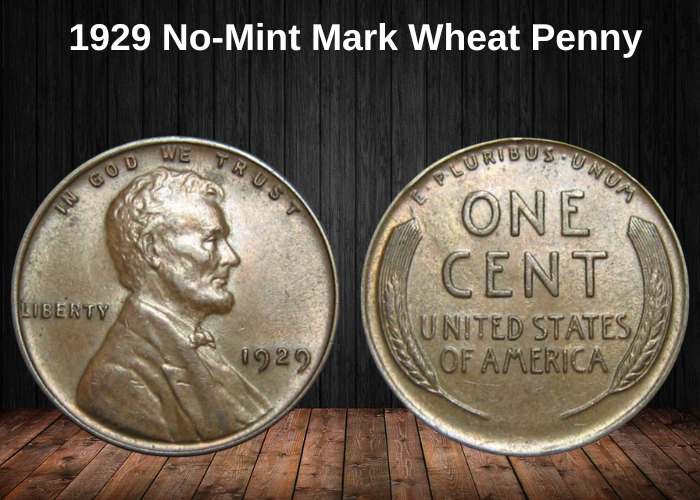
The 1929 no-mint mark wheat penny was struck in large numbers by the Philadelphia Mint, with an estimated mintage of 185,262,000 coins, making it quite common. Even high-quality, red coins from this year are relatively affordable for collectors.
Price Range for 1929 No-Mint Mark Wheat Penny:
- Circulated Condition (Brown Coins):
- Brown pennies in circulated condition generally range in value from $0.20 to $6.
- Red Coins (Uncirculated):
- Red coins, especially in gem quality, are highly sought after:
- A MS62 red penny can typically be priced around $26.
- However, top-tier examples with exceptional quality can reach up to $7,000.
- Red coins, especially in gem quality, are highly sought after:
- Record Auction Sale:
- The highest price for a 1929-P wheat penny was $5,581 for a red MS67 coin, sold by Heritage Auctions in 2014.
Though the 1929 no-mint mark wheat penny is abundant, its value can significantly increase if it’s in top condition, particularly with red coloring and high-grade ratings.
1929-S Wheat Penny Value
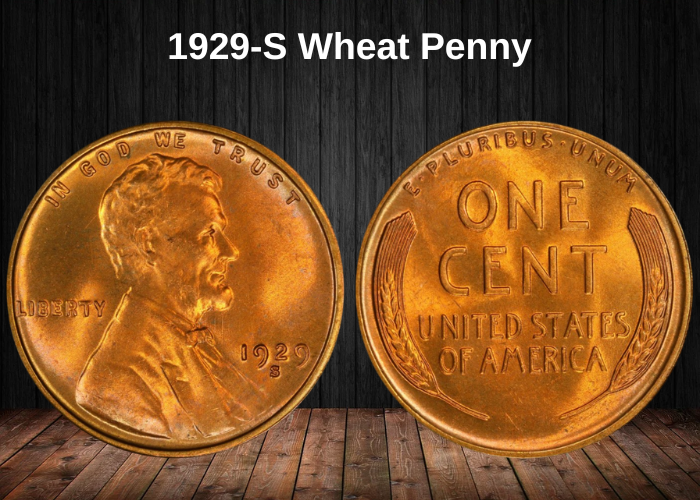
In 1929, the San Francisco Mint struck approximately 50,148,000 wheat pennies, which is a lower mintage compared to the number from Philadelphia. Despite this, the 1929-S wheat pennies are still fairly common across various grades due to many of them being saved in rolls.
However, 1929-S coins typically show signs of moderate to heavy die erosion, making well-struck gem examples more difficult to find.
Value of the 1929-S Wheat Penny:
- Circulated Condition:
- The value of circulated 1929-S pennies generally ranges from $0.50 to $18 depending on the quality.
- Uncirculated Examples:
- MS66 graded coins can fetch up to $160.
- Fully Red Coins:
- Red coins in mint state can command as much as $2,850.
- Record Sale:
- A red 1929-S penny graded MS66+ fetched an impressive $18,600 at a 2022 Heritage Auctions sale.
In short, while the 1929-S is not as rare as some other pennies, high-quality examples with well-struck details and red coloring can be highly valuable.
1929-D Wheat Penny Value
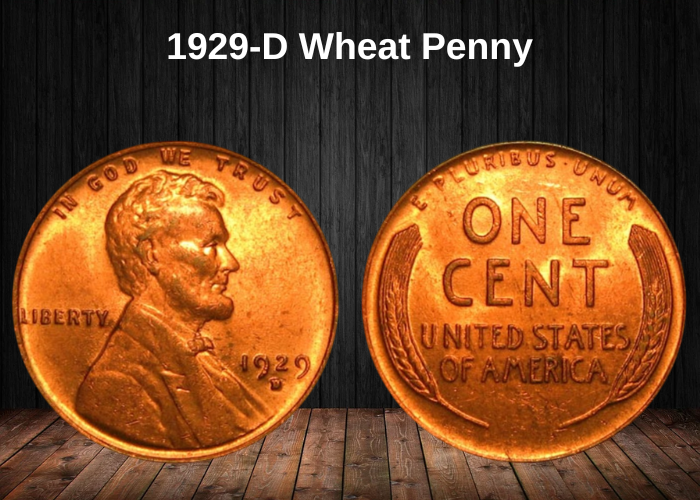
The 1929 wheat pennies struck at the Denver Mint feature a D mint mark right below the date. The Denver mint produced approximately 41,730,000 of these coins, the lowest mintage for the year. Many of the 1929-D wheat pennies showed signs of poor striking due to worn-out dies, resulting in blurring on the wheat ears on the reverse, as well as the date and Lincoln’s portrait.
Value of the 1929-D Wheat Penny:
- Circulated Condition:
- A 1929-D wheat penny in circulated condition typically ranges from $0.35 to $20 depending on the wear.
- Uncirculated Examples:
- MS66 graded 1929-D wheat pennies can sell for up to $400.
- Fully Red, Gem Coins:
- A fully red, gem-quality 1929-D wheat penny is rare, but if you find one, it may be worth about $2,650.
- Record Sale:
- The most expensive 1929-D wheat penny, graded MS66+, sold for an impressive $7,800 during a 2021 Heritage Auctions sale.
Despite the poor strikes due to worn dies, higher-quality examples, especially those with full strike and red color, can be quite valuable.
Rare 1929 Wheat Penny Errors List
1929 Doubled Die Wheat Penny Error
The 1929 Doubled Die Wheat Penny Error is a common minting issue seen on many wheat pennies from this year.
This error happens when the punching die strikes the coin at a slightly misaligned angle, resulting in a doubling effect on parts of the design or lettering.
Where Doubling Can Be Seen:
- Obverse (Front):
- The inscription “IN GOD WE TRUST” and the word “LIBERTY” are typically where you can spot the doubling.
- Reverse (Back):
- The motto “E PLURIBUS UNUM” and the wheat ears feature noticeable doubling.
Value of the Error:
- The value of a 1929 Doubled Die Wheat Penny varies based on the severity of the doubling:
- Mild doubling: These can generally range from $20 to $50.
- Strong doubling: If the doubling is very prominent, the value can increase to $100 or more.
It’s worth noting that the presence of the error can significantly increase the coin’s desirability for collectors, as this type of mistake is highly sought after for its rarity and unique nature.
1929 Re-punched Mint Mark Wheat Penny Error
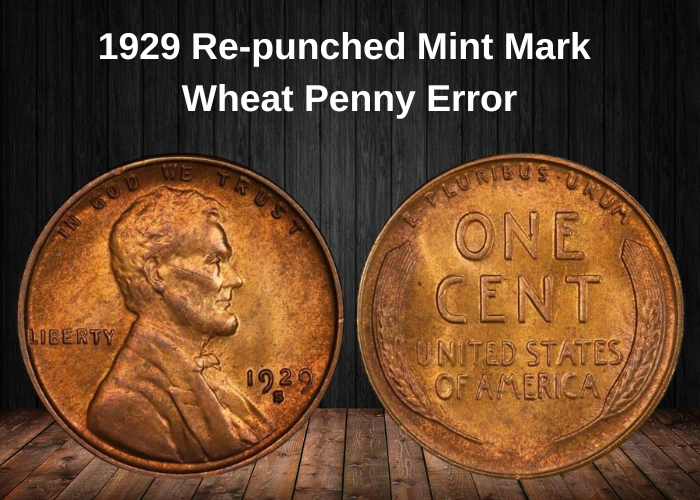
A re-punched mintmark error occurs when the mint mark is stamped multiple times on a coin, causing overlapping impressions. This typically happens when the mint mark punch is misaligned during the minting process, resulting in a double imprint of the same letter.
This error is fairly common in 1929 wheat pennies minted across all three locations (Philadelphia, Denver, and San Francisco). Collectors find these errors particularly interesting due to their unique appearance.
Value of the Error:
- Depending on the visibility and severity of the re-punching, a re-punched mintmark on a 1929 wheat penny can be worth between $10 and $100.
Coins with this error are popular with error coin collectors, making them a desirable addition to many collections. If the mintmark is clearly visible and in excellent condition, the value could even reach higher amounts.
1929 Off-Center Wheat Penny Error
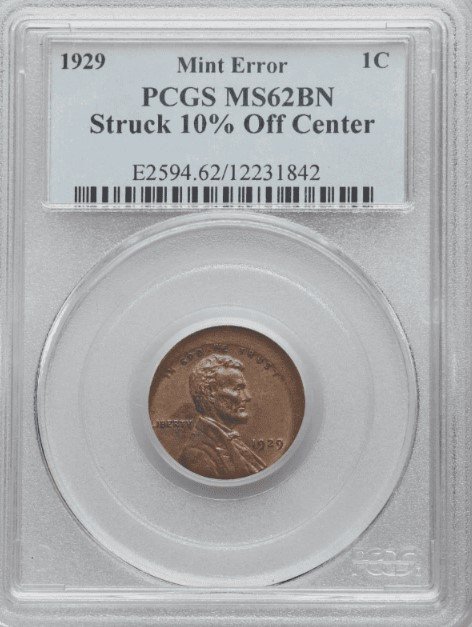
Another common error found in 1929 Lincoln wheat pennies is the off-center error.
This occurs when the planchet (the blank metal disc used to make the coin) is not properly aligned within the collar during the minting process. As a result, part of the coin’s design is missing from both the obverse and reverse sides.
Off-center errors are highly sought after by coin collectors, especially those who specialize in minting errors. The value of these errors depends on the extent of the off-center strike. Generally, off-center errors with a greater percentage of the design missing (over 50%) are more valuable than those with a smaller misalignment.
Value:
- Typical off-center error coins from 1929 can fetch anywhere from $30 to $100, depending on the degree of misalignment.
- Coins with larger off-center percentages, especially those with 50% or more of the design missing, tend to be priced higher.
Collectors highly appreciate this error for its unique appearance and the rarity of coins that exhibit a significant misalignment.
Where to sell your penny?
Now that you know the value of your penny, you might be wondering where to sell it. Don’t worry: here’s a guide to some of the best online platforms where you can easily sell your coins, along with their advantages and disadvantages.
Discover the best platforms for selling coins online (pros and cons).
FAQ
1. What makes the 1929 Wheat Penny historically significant in the context of the Great Depression?
The 1929 Wheat Penny is particularly noteworthy because it was minted just months before the stock market crash in October 1929, which led to the Great Depression. It marks the end of an era of economic prosperity during the Roaring Twenties and serves as a tangible reminder of the transition into one of the most challenging periods in U.S. history.
2. How does the mintage of the 1929 Wheat Penny compare to other coins from the 1920s?
The 1929 Wheat Penny had a total mintage of 193,130,000 coins, making it one of the higher mintage years in the Wheat Cent series. While this figure is high, it’s still lower than the numbers seen in earlier years of the decade, such as 1927 and 1928. This large mintage ensures that the 1929 penny is relatively common, though it can still be found in various grades and conditions.
3. Why is the 1929-D Wheat Penny more valuable than the 1929 Philadelphia issue?
The 1929-D has a mintage of 10,617,000, which is significantly lower than the 1929 Philadelphia penny. While the 1929-D is still considered a common coin, its relative scarcity compared to the Philadelphia issue increases its appeal to collectors, especially those looking for a less common example from the year. Coins in higher grades, such as MS64 or MS65, can command premiums over the more abundant Philadelphia version.
4. What impact does the condition and strike quality of the 1929 Wheat Penny have on its value?
The value of the 1929 Wheat Penny is heavily influenced by its strike quality and condition. Well-struck coins from the Philadelphia mint tend to have sharper details compared to those from the Denver Mint, which can sometimes exhibit weaker strikes. Coins with original red (RD) coloration, especially those in uncirculated grades like MS64 or MS65, are highly sought after and can see significant price increases.
5. Are there any known die errors or varieties that add value to the 1929 Wheat Penny?
The 1929 Wheat Penny series is not known for major varieties or error coins, but as with other years in the series, there are occasional die cracks, double die errors, and off-center strikes. These minor flaws, especially in high-grade coins, can increase the appeal to collectors looking for more unique specimens. However, there are no major varieties that consistently add significant premiums to the 1929 Wheat Penny.
6. How does the economic climate of 1929 influence the rarity of the 1929 Wheat Penny?
The 1929 Wheat Penny was produced in an environment of looming economic uncertainty, which eventually led to the Great Depression. The large number of coins minted that year reflects the continuation of a robust economy, but the eventual economic downturn meant that fewer coins were saved in high grades. Many of the 1929 pennies circulated heavily during the Depression, leading to fewer examples in pristine condition, thus making uncirculated or high-grade examples more valuable today.
7. What is the investment potential for the 1929 Wheat Penny, and which variety is most likely to appreciate over time?
The 1929-D Wheat Penny offers the best investment potential among the varieties of that year. Due to its lower mintage, it’s more likely to appreciate in value, particularly in higher grades such as MS64 or higher, and in red or red-brown (RB) condition. While the 1929 Philadelphia penny is common and unlikely to see significant long-term growth in value, the 1929-D offers the best opportunity for gradual price increases over time, especially as demand for better-preserved examples continues to rise.



















































